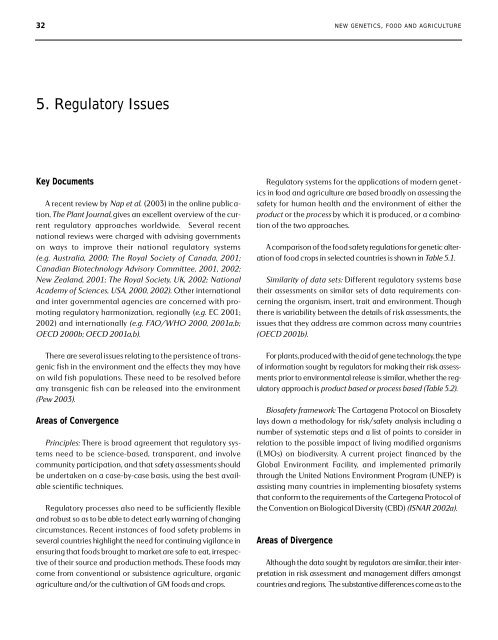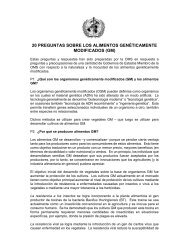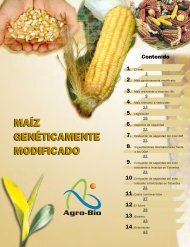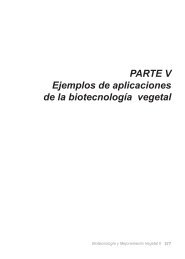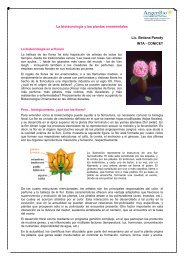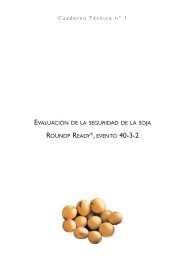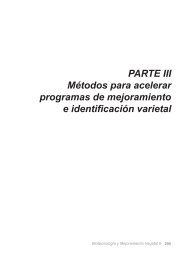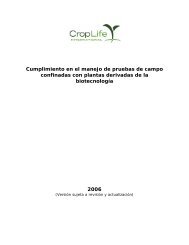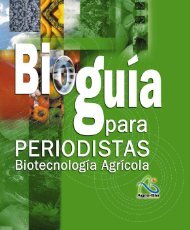32N E W G E N E T I C S, F O O D A N D A G R I C U LT U R E5. Regulatory IssuesKey DocumentsA recent review by Nap et al. (2003) in the online publication,The Plant Journal, gives an excellent overview of the currentre g u l ato ry approa c h es wo r l dwide. Seve ral re ce n tn ational rev i ews we re charged with advising gove r n m e n t son ways to improve their national re g u l ato ry sys tems( e .g. Aus tra l i a, 2000; The Royal Soc i e ty of Can a d a, 2001;Can a d i an Biotec h n ol ogy Advi s o ry Co m m i ttee, 2001, 2002;<strong>New</strong> Zea l an d, 2001; The Royal Soc i e ty, UK, 2002; Nati o n a lAcademy of Sciences, USA, 2000, 2002). Other international<strong>and</strong> inter gove r n m e n tal agencies are co n cerned with promo ting re g u l ato ry har m o n i zation, regionally (e.g. EC 2001;2002) <strong>and</strong> inte r n ationally ( e .g. FAO/WHO 2000, 2001a, b ;OECD 2000b; OECD 2001a,b).There are several issues relating to the persistence of transgenicfish in the environment <strong>and</strong> the effects they may haveon wild fi sh po p u l ations. These need to be res ol ved be fo reany transgenic fi sh can be re l e ased into the env i ro n m e n t(Pew 2003).Areas of ConvergencePr i n c i pl es : T h e re is broad agreement th at re g u l ato ry systemsneed to be science - bas e d, tran s pare n t, <strong>and</strong> invol vecommunity participation, <strong>and</strong> that safety assessments shouldbe undertaken on a case-by-case basis, using the best availablescientific techniques.Re g u l ato ry proces s es also need to be suffi c i e n tly fl e x i bl e<strong>and</strong> rob ust so as to be able to detect early warning of chan g i n gc i rcum s tan ces. Re cent instan ces of food safe ty problems ins eve ral co un tr i es highlight the need for co n ti n uing vigilan ce ine n s uring th at foods brought to mar ket are safe to eat, irres pe c-tive of their source <strong>and</strong> produ c tion meth ods. These foods maycome from co nve n tional or subsiste n ce agr i cu l ture, org an i ca gr i cu l ture an d /or the cu l tivation of GM foods <strong>and</strong> crops.Regulatory systems for the applications of modern geneticsin food <strong>and</strong> agriculture are based broadly on assessing thes afe ty for hum an health <strong>and</strong> the env i ronment of either th eproduct or the process by which it is produced, or a combinationof the two approaches.A co m parison of the food safe ty re g u l ations for genetic alte r-ation of food crops in selected co un tr i es is sh own in Ta ble 5.1.Si m i l ar i ty of data sets: D i ffe rent re g u l ato ry sys tems bas etheir as s essments on similar sets of data re q ui rements co n-cerning the organism, insert, trait <strong>and</strong> environment. Thoughthere is variability between the details of risk assessments, theissues that they address are common across many countries(OECD 2001b).For pl an t s, produ ced with the aid of gene te c h n ol ogy, the typeof info r m ation sought by re g u l ato rs for making their risk as s es s-ments prior to env i ro n m e n tal re l e ase is similar, wh e ther the re g-u l ato ry approach is p roduct bas ed or process bas ed (Ta ble 5.2).B i o s afe ty fram ew o r k :The Car tagena Pro tocol on Biosafe tyl ays down a meth od ol ogy for risk /s afe ty an a l ysis including an um ber of sys te m atic steps <strong>and</strong> a list of points to consider inre l ation to the po s s i ble impact of living mod i fied org an i s m s( LMOs) on biod ive rs i ty. A cur rent project fi n an ced by th eG l obal Env i ronment Fa c i l i ty, <strong>and</strong> impl e m e n ted primar i l yth rough the Un i ted Nations Env i ronment Program (UNEP) isas s i s ting many co un tr i es in impl e m e n ting biosafe ty sys te m sth at co n form to the re q ui rements of the Car tegena Pro tocol ofthe Co nve n tion on Biol og i cal Dive rs i ty (CBD) ( I SNAR 2002a).Areas of DivergenceAl though the data sought by re g u l ato rs are similar, their inte r-p re tation in risk as s essment <strong>and</strong> management diffe rs am o n g s tco un tr i es <strong>and</strong> regions. The substan tive diffe re n ces come as to th e
N E W G E N E T I C S, F O O D A N D A G R I C U LT U R E 33l evel of risk re g u l ato rs consider will be acce p ta ble for a given soc i-e ty. Si n ce biol og i cal sys tems do not deliver ce r tai n ty, ze ro risk fo rany new te c h n ol ogy is an un attai n a ble stan d ard.Managing un ce r tai n ty: T h e re re m ains a diffe re n ce of view inh ow to co pe with un ce r tai n ty in risk as s essments. One approa c his where risk management might be applied in advance ofassessment, so that risks which, based on current scientifick n owledge, could not be as s essed rationally are simply avo i d e d .A num ber of co un tr i es apply such a p reca uti o n ary a p p roa c h .Oth e rs be l i eve th at it is not po s s i ble to manage risks th at can n o tbe as s essed rationally <strong>and</strong> th at governments should focus onas s essing <strong>and</strong> managing identi fi a ble risks ( O ECD 2001b).Extent of risk assessments required: Other regulators considerth at the extent of risk as s essments should be pro po r-ti o n ate to the degree of risk invol ve d, <strong>and</strong> th at this can bed e termined when the new produ c t /p rocess is co m pare dw i th its co nve n tional co un te r part with which th e re is somefam i l i ar i ty. This approach of re g u l ating the produ c t, an dassessing its degree of familiarity or difference with presentproducts is the basis of the regulatory system in the USA.Co m parative risk as s essments: Other issues th at re m ai nunder debate are whether assessment of risk <strong>and</strong> uncertaintyshould be applied primarily to new te c h n ol og i es or sh o u l dalso be applied to conventional agricultural practices (OECD2001b; US NAS 2002). Others consider that both the risks <strong>and</strong>benefits of new technologies need to be considered, in comparisonwith present agricultural practices.Ha zard identi fi cation: While the like l i h ood of harm is afun c tion of bo th hazard <strong>and</strong> expo s ure, the public debate isd o m i n ated by hazard identi fi cation, often neglecting issuessuch as exposure <strong>and</strong> the likelihood of harm, an evaluation ofthe final co n s e q u e n ce <strong>and</strong> a co m parison with the presents i tu ation. The cove rage of po te n tial harm to the Mo n arc hb utte r fly by Bt mai ze is an exam ple of this focus on hazardidentification (Pew 2002; Shelton <strong>and</strong> Sears 2001).Gaps in KnowledgeMost re g u l ato ry sys tems agree on the need to co n ti n u a l l yi m p rove risk as s essment meth od s, making use of new scientific deve l o p m e n t s, so th ey keep abre ast of emerging products<strong>and</strong> proces s es. Re g u l ato ry sys tems also need to be suffici e n tly fl e x i ble so as to res pond to accum u l ating expe r i e n cein the be h av i o ur of new products once th ey are in wides p re a duse.Improving food safety assessments: There is a need for continueddevelopment of food safe ty as s essments meth od s, s oas to as s ess the safe ty of future products th at may be th eresult of more complex genetic modifications (e.g. foods withm od i fi cations to their nutrient co n tent). For exam ple, newscientific developments in areas such as metabolomics <strong>and</strong>p ro te o m i cs may enable the co n tent of wh ole foods to beassessed, thus improving on the present concept of substantialeq uiv a l e n ce wh e re by a limited num ber of targ e tedcompounds are compared between the new product <strong>and</strong> itsco nve n tional co un te r part food. These scienti fic deve l o p-ments will also enable better monitoring of any unintendedchanges in the content of foods that may result from geneticm od i fi cation. Such chan g es may occur either by co nve n-tional breeding or gene technology.I m p roving envi ro n m e n tal as s essments: One of the are aswhere there is most deb ate is on the methods used to assesse nv i ro n m e n tal impa c t, <strong>and</strong> on wh at co n s ti tutes an adve rs eenvironmental impact. One approach is to compare GMOsw i th org anisms produ ced using more tra d i tional bre e d i n gtechniques. Some of the outst<strong>and</strong>ing issues in assessing environmentalimpacts are the lack of reliable baseline data, there l evan ce of extra pol ation from small- to large- scale us e ,<strong>and</strong> from the labo rato ry to the fi e l d, ability to detect rareevents within a relatively short experimental time scale, lagsbe tween introdu c tion <strong>and</strong> man i fes tation of env i ro n m e n ta limpacts <strong>and</strong> the lack of knowledge about the complexity ofe co sys te m s, including soil eco sys tems. Assessment of th ei m pacts of GMOs on non-target org anisms needs to re fl e c tthe co m pl e x i ty of diffe rent env i ro n m e n t s, <strong>and</strong> the need fo rcomparison with other agricultural practices.Ce n tre of div e rs i ty data: R i sk as s essments of geneti ca l l ymodified crops have focused mainly on agronomic cha racteristicsin temperate regions. Comparative risks <strong>and</strong> benefitsof the introdu c tion of LMOs with alte r n ative cu l tivati o nmethods need to be assessed on a case-by-case basis, takingi n to acco unt regional agr i cu l tural pra c ti ces an d, wh e re
- Page 1 and 2: I N T E R N ATIONAL COUNCIL FOR SCI
- Page 3 and 4: I N T E R N ATIONAL COUNCIL FOR SCI
- Page 7 and 8: N E W G E N E T I C S, F O O D A N
- Page 10 and 11: 8N E W G E N E T I C S, F O O D A N
- Page 12 and 13: 10N E W G E N E T I C S, F O O D A
- Page 14 and 15: 12N E W G E N E T I C S, F O O D A
- Page 16 and 17: 14N E W G E N E T I C S, F O O D A
- Page 18 and 19: 16N E W G E N E T I C S, F O O D A
- Page 20 and 21: 18N E W G E N E T I C S, F O O D A
- Page 22 and 23: 20N E W G E N E T I C S, F O O D A
- Page 24 and 25: 22N E W G E N E T I C S, F O O D A
- Page 26 and 27: 24N E W G E N E T I C S, F O O D A
- Page 28 and 29: 26N E W G E N E T I C S, F O O D A
- Page 30 and 31: 28N E W G E N E T I C S, F O O D A
- Page 32 and 33: 30N E W G E N E T I C S, F O O D A
- Page 36 and 37: 34N E W G E N E T I C S, F O O D A
- Page 38 and 39: 36N E W G E N E T I C S, F O O D A
- Page 40 and 41: 38N E W G E N E T I C S, F O O D A
- Page 42 and 43: 40N E W G E N E T I C S, F O O D A
- Page 44 and 45: 42N E W G E N E T I C S, F O O D A
- Page 46 and 47: 44N E W G E N E T I C S, F O O D A
- Page 48 and 49: A n n e x e sA. Bibliographic ListB
- Page 50 and 51: N E W G E N E T I C S, F O O D A N
- Page 52 and 53: N E W G E N E T I C S, F O O D A N
- Page 54 and 55: N E W G E N E T I C S, F O O D A N
- Page 56 and 57: N E W G E N E T I C S, F O O D A N
- Page 58: I N T E R N ATIONAL COUNCIL FOR SCI


